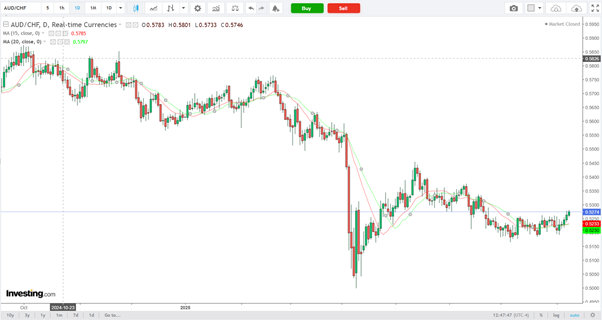In the complex world of foreign exchange markets, traders and investors diligently track the ebb and flow of currencies as they respond to global economic shifts, policy changes, and investor sentiment. This article embarks on a comprehensive journey through the nuanced landscapes of several currency pairs, offering insights into recent movements and potential future trajectories.
Starting with the Australian Dollar against the Swiss Franc (AUD/CHF), we’ve observed oscillation within the bounds of 0.5170 and 0.5308 for numerous weeks, following a notable descent from March into mid-April. The price trajectory has gravitated towards the upper limit of this range, nudging against the 0.5308 marker, a level that has historically switched roles between support and resistance since the dawn of May.
Indicators such as the 15-day and 20-day Simple Moving Averages (SMAs) have begun to level out, hinting at a decreased downward momentum and possibly foreshadowing a shift towards a bullish or at the very least, a neutral stance. Should the currency pair breach the 0.5308 threshold decisively, it could clear a path towards higher levels, specifically in the vicinity of 0.5440 to 0.5580. On the flip side, a rejection at this critical juncture might trigger a regression back to the 0.5170 support realm.
The dance between the Australian Dollar and the US Dollar (AUD/USD) paints a similar picture but in slightly different shades. Post navigating through a recovery phase from lows earlier in the year, the pair has been meandering between 0.6450 and 0.6605 in recent months. With the current price challenging the 0.6518 resistance line, a significant pivot point that has witnessed multiple interactions since mid-year.
The alignment and flattening of the 15-day and 20-day SMAs mirror a period of consolidation, with volatility at a low following the uptick from April to June. A convincing leap over the 0.6605 mark might set the stage for an ascent towards 0.6800, whereas failure to overpower this resistance could see the pair retracing back towards the 0.6450 support zone.
Similarly, the Euro against the US Dollar (EUR/USD) scenario illustrates a period of consolidation after a spirited rally from March lows, with price currently probing the 1.1639 horizontal pivot. This pivotal level has played a versatile role, oscillating between support and resistance through the tail end of May.
In a parallel narrative, the GBP/USD and USD/CAD pairs each narrate a story of tentative resurgence and cautious optimism. The GBP/USD, for instance, has seen a recent correction following an uptrend, now delicately positioned at the 1.3445 pivot. Here, future movements are eagerly anticipated, contingent upon whether bullish forces can overpower the current resistance or succumb to a further pullback.
Likely, USD/CAD’s narrative evolves around a recent breakout above a salient resistance, signaling a potential reversal from its prolonged downtrend since late January. Here, sustaining gains above crucial levels remains pivotal for affirming a bullish conviction.
Furthermore, USD/CHF and USD/JPY scenarios echo the theme of consolidation post-rally, with each pair at a crossroads, displaying signals of either continuation or reversal based on their ability to breach or defend key support and resistance zones.
Lastly, the journey through the USD/ZAR pair uncovers a tale of a downtrend since reaching peaks near 19.90 in April. The current landscape suggests a cautious bearish bias, with potential for further declines unless a strong recovery materializes from the incumbent support zones.
In conclusion, the foreign exchange market remains a testament to the dynamic interplay of global economic forces, investor sentiment, and technical factors. As currencies navigate through pivotal levels, the unfolding patterns offer a glimpse into the broader narrative of market sentiment, economic health, and the relentless pursuit of equilibrium in the ever-evolving financial landscape.


